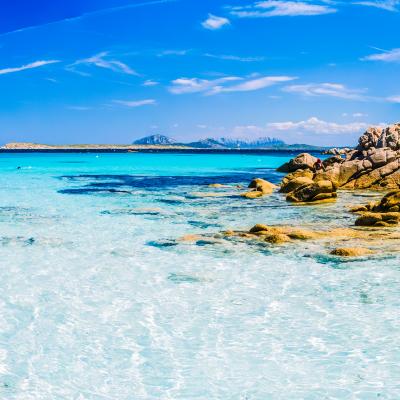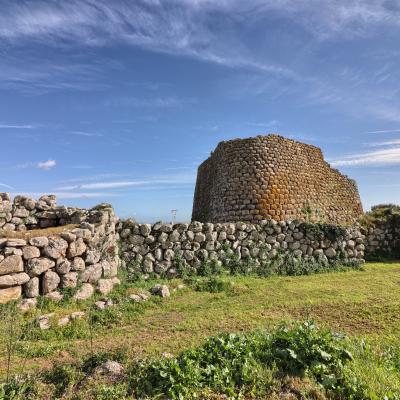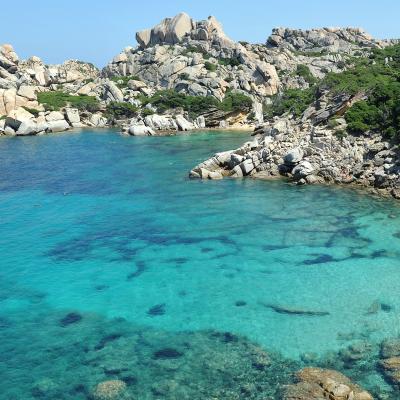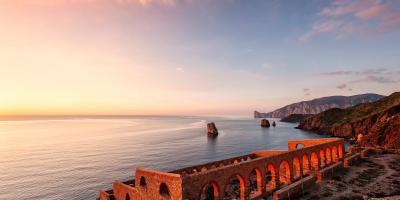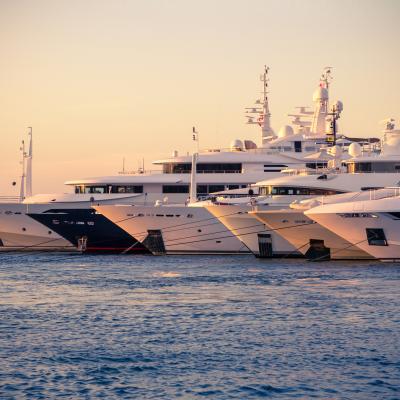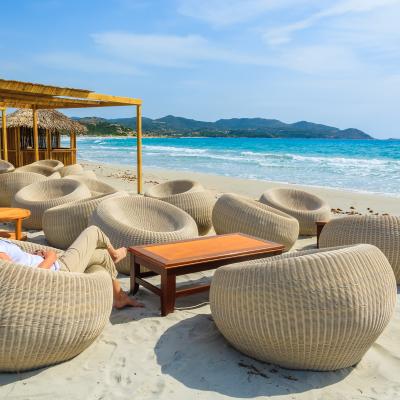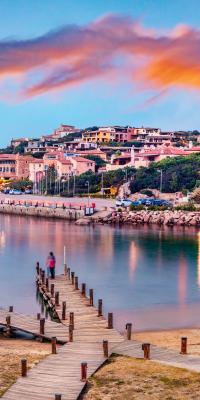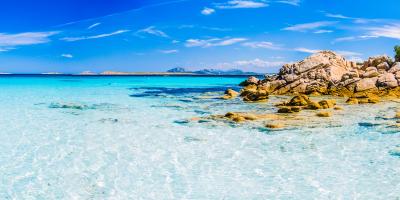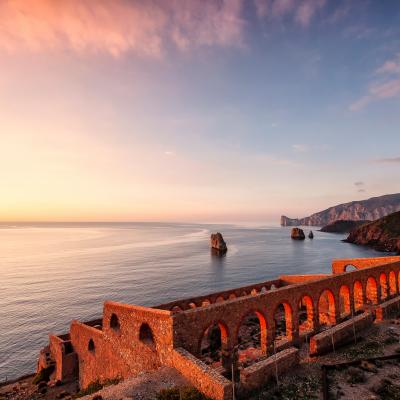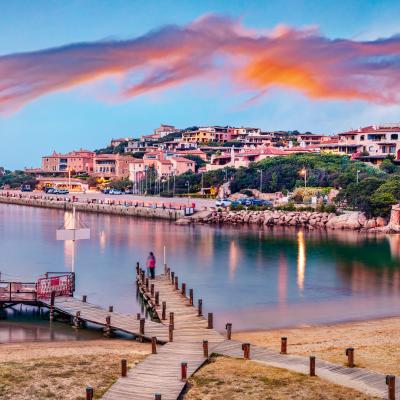Sardinia
Sardinia amazes the visitor with its natural contrasts, ancient traditions and its wildness, given by the great variety of flora and fauna. Indeed, man is almost a rare presence in certain areas. Located in the center of the Mediterranean with a predominantly mountainous terrain, Sardinia gives the visitor a unique natural environment. It is characterized by many natural treasures, such as mountain massifs rich in caves, deserted beaches of white sand and lush forests, with trees even thousands of years old. The region's capital is Cagliari, endowed with a rich historical and artistic heritage. Within the province, the Molentargius-Saline Regional Nature Park is a rare example of an ecosystem found in heavily man-made areas. For the exceptional number of birds that find refuge there, it is recognized as one of the most important areas in Europe The sea reigns supreme with its 2,000 kilometers of coastline, making it one of the most admired in the world. The most popular locations are the Emerald Coast with Porto Cervo and its Porto Vecchio, considered the best equipped marina in the Mediterranean. La Maddalena, with its windy islands full of natural inlets and characteristic landings, is an ideal destination for sailing vacations. There are many beautiful beaches in the province of Cagliari, far from mass tourism and often uncrowded, but La Pelosa di Stintino and the Saline remain the region's most iconic beaches. Sailing from Caprera to the Bocche di Bonifacio, one comes across the curious phenomenon of the pink beach (due to peculiar corals and shells) of Budelli Island.
For mountain lovers, on the other hand, Gennargentu is the main mountain group with its 1834 meters of altitude. Among its wonders, Sardinia tourism offers visitors the Nuraghi, ancient stone towers that constitute the largest and best-preserved monuments in Europe. Among the many, the Barumini complex is on the UNESCO World Heritage list. North of Alghero is Sardinia's only lake, Lake Baratz, which is small (its perimeter reaches 12 kilometers) but very impressive. It is worth making an excursion to Asinara National Park on the island of the same name, considered one of the most enchanting in the entire Mediterranean. A variety of activities can be done within the park: trekking, biking, horseback riding, sailing and guided diving.
The beaches
Cala Goloritzé can be reached via two routes: one by land and the other by sea. By land, it is possible to make a trekking route by starting on foot from Su Porteddu. From here, paths originate that lead to Cala Luna and continue to Cala Goloritzè.
It is definitely the most famous beach in the Gulf of Orosei. The ultra-transparent water has a bottom of about 30 meters and has a somewhat colder temperature than the other coves due to the presence of currents of icy water from the nearby river. A wild cove and no beach facilities are present. Totally untouched!
Porto Istana is actually a set of four beaches separated from each other by small rocky strips. The beach is located a short distance from Porto San Paolo, in the locality of Murta Maria south of Olbia. Its sand is very white and the sea emerald. The beach is connected to Olbia by bus service. The sandy shore is made up of fine white sand that slopes gently toward the emerald colors of its waters, so it is particularly suitable for bathing, especially for children. Located in front of the island of Tavolara, it is a destination for many diving and surfing enthusiasts.
The Prince's Beach is one of the most beautiful beaches on the Emerald Coast. Its name is linked to Prince Aga Khan frequenter of this corner of the sea (and founder of the Emerald Coast). Very fine sand bordered by rocks and surrounded by Mediterranean scrub. The color and clarity of this sea is due to the unique mixed sand and granite seabed. This small beach is often considered the most beautiful beach on the Emerald Coast and one of the most beautiful beaches in Sardinia.
The beach of Porto Giunco is located a short distance from the town of Villasimus about 45 km from Cagliari. The crystal clear sea is so clear and transparent that it resembles a typical Caribbean beach. It has a bottom of fine white sand. Its waters are a soft blue, and this has attracted many advertisers, who have made it an unparalleled setting for their commercials. In the area there is the pond of Notteri, where it is possible to admire several specimens of pink flamingos Pelosa beach is considered one of the most beautiful beaches in Italy and Europe. It is a natural paradise where fine sand and very shallow seabed with water that reaches the ankles for tens of meters. A true paradise! Unmissable stop among the wonderful beaches in Sardinia. Located in the Gulf of Asinara, in the extreme northwestern tip of Sardinia. It is only 2 km from the small town of Stintino. Opposite is a small island with an Aragonese tower dating from 1578. The tower is the symbol of Pelosa, which can be reached on foot after passing through another delightful cove, La Pelosetta. Between the stacks of Capo Falcone, the Piana island and Asinara that forms the backdrop to this spectacular landscape. Curiosity related to its name: it is said to be so named because of the presence of sea straw, and Mediterranean vegetation composed of long, fine tufts If you visit Tuerredda beach you are lucky enough to see one of the most beautiful beaches in the world! On the south coast of Sardinia, a few km from Chia and about 50 km from Cagliari.
Something unique and of rare beauty. Particular because it is formed by a very suggestive inlet overlooking a sea colored in all shades of blue: from turquoise, to the deepest blue to emerald green, recalling the style of Caribbean beaches.
Fine white sand, suitable for those who like to relax, families, due to the presence of not too deep waters.
Beautiful swim to the 'islet about 100 meters from the beach where stands the small tower (hence the name Tuerredda).
One of the most beloved and popular beaches in Southeast Sardinia in the municipality of Castiadas. In Santa Giusta beach, the temperature of 'water in the stretch of sea where the seabed is shallower is quite mild, making it a real natural swimming pool.
This is one of the perfect beaches for families with children who love to climb and dive into the shallow and transparent waters! The beach is characterized by the presence of large, rather smooth granite rocks where you can climb, walk or sit and admire the transparency of these Caribbean waters!
It seems it was a favorite destination of the fisherman Peppino from which the name of this beach derives, known in fact as "Peppino's Rock".
The beach of Su Giudeu is located about 2 km from Chia. It is considered one of the most beautiful beaches in the Mediterranean: very long, very clear sand and deep blue sea. Surrounded by dunes up to 20 meters high.
On the right side of the shoreline, there is the islet of Su Giudeu: a huge rock, on which, in spring, goats are used to graze.
It can be reached partly by walking on the sandy shallows that sometimes emerge completely from the water, and partly by swimming a few dozen meters. From the top you can admire the panorama of the Chia coast.
Cala Brandinchi is called Little Tahiti is a dream beach, with fine white sand and turquoise water. The green of the pine forest and Mediterranean scrub is made even more intense by the extraordinary colors of the sea, reminiscent of those in Polynesia.
In low season this stretch of coast gives the maximum of its splendor, especially from September to June: enchanting vegetation, very fine white sand and the transparency of the sea reach the TOP!"
The beach of Punta Molentis is located in the Southeast coast between Villasimius and Costa Rei. It is about 6 km from Villasimius. It has very fine white sand with faint streaks of pink in the shoreline.
The crystal clear sea creates a beautiful coloration that varies from light emerald green, to turquoise, to azure. It is quite sheltered from the wind, it is also surrounded by dense and flourishing Mediterranean scrub.
On the promontory overlooking Punta Molentis beach, once stood the Nuraghe of Punta Molentis, the remains of which remain today and from where you can admire a splendid panorama.
What to eat
Sardinian cuisine is a rich and ancient heritage of flavors, capable of satisfying the most demanding palates with a simple taste rich in natural ingredients. The protagonist is wheat, processed to produce the famous carasau bread, a very thin and crispy unleavened crust, baked twice. Delicious are the coarse pastas: culurgiones, filled with a mixture of pecorino cheese, potatoes and mint; and malloreddus, small gnocchi with a sauce made with sausage, tomato, bay leaf, saffron and pecorino cheese. Sardinian cuisine includes several variations of couscus, called fregula, with small or large grain; it can be cooked in various ways, with meat, fish, served cold or with broth. The quintessence of Sardinian gastronomy is porceddu, a simple suckling pig roasted and served on cork trays sprinkled with myrtle branches.
Those who love the flavors of the sea cannot help but try lobster from Alghero, bottarga from Cabras, burrida and tuna from Carloforte. As far as dairy tradition is concerned, Sardinia boasts the record in sheep's milk cheese production in Europe. In addition to the various DOP pecorino cheeses, Pirittas, Bonassai, Pischedda, Frue, Brotzu and Biancospino are also worth trying. The region's most important desserts are pardulas with semolina and ricotta cheese, seadas, doughnuts stuffed with sour cheese, fried and drizzled with honey, and aranzadas, which take the form of pastries made of almonds, oranges and honey. The basic ingredient for most of the characteristic pastries is almonds, with which macaroons are made. As an accompaniment to Sardinian dishes, excellent wines such as Vermentino di Gallura DOCG and Cannonau DOC cannot be missed. Also wonderful is myrtle liqueur, in the red and white varieties, made from the fruits of this plant that is widespread on the island.
